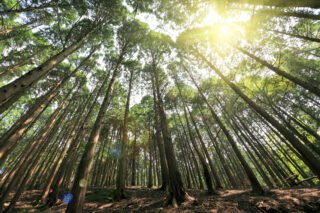Table of Contents
- Characteristics of the Longleaf Pine
- Importance of the Longleaf Pine to Alabama
- Conservation and Future of the Longleaf Pine
- FAQ
- Q: What is the official state tree of Alabama?
- Q: When was the Longleaf Pine designated as the official state tree of Alabama?
- Q: Where is the Longleaf Pine native to?
- Q: What are the characteristics of the Longleaf Pine?
- Q: What is the economic value of the Longleaf Pine?
- Q: How does the Longleaf Pine benefit the soil?
- Q: What is the preferred habitat for the Longleaf Pine?
- Q: How tall can the Longleaf Pine grow?
- Q: What organizations are involved in the conservation of the Longleaf Pine?
- Q: How large was the longleaf pine ecosystem in the past?
As a journalist, I am excited to introduce you to the official state tree of Alabama – the Longleaf Pine (Pinus palustris). Designated by the Alabama legislature in 1949, this majestic tree has played a significant role in the state’s history and economy.
- The Longleaf Pine is the official state tree of Alabama.
- Designated as such by the Alabama legislature in 1949.
- The Longleaf Pine has played a significant role in Alabama’s history and economy.
- Alabama is one of many states with official state trees.
Characteristics of the Longleaf Pine
As one of the southern pine trees, the Longleaf Pine (pinus palustris) has distinct characteristics that make it stand out. It has long, slender needles that can reach up to 18 inches in length, making it unique compared to other pine trees such as the loblolly pine or slash pine. The Longleaf Pine also produces large cones, up to 10 inches long, which are essential for seed dispersal and regeneration within the pine ecosystem.
The Longleaf Pine ecosystem, once covering vast areas in the southeastern United States, has unique properties. It provides habitat for many plant and animal species, making it an important part of the region’s biodiversity. Unfortunately, the Longleaf Pine is an endangered species, and its ecosystem is threatened by land conversion and degradation.
Efforts are being made to conserve the Longleaf Pine and its ecosystem. The Longleaf Pine was designated as the official state tree of Alabama by the state legislature in 1949, highlighting its significance to the state’s culture and history. Additionally, organizations such as the Forest Service, Fish and Wildlife Service, and the Department of Agriculture are working to protect the Longleaf Pine ecosystem.

In terms of growth habits, the Longleaf Pine can reach heights of up to 100 feet at maturity. However, it has a unique shrub-like appearance when it is young, with a single stem and a tuft of needles at the top. The Longleaf Pine thrives in well-drained soil, making it a common sight in coastal areas. It is native to the southeastern United States and is an integral part of the region’s pine ecosystem.
Overall, the Longleaf Pine has a critical role in the southeastern United States’ ecology and economy, providing habitat for many species and being a valuable resource for timber and lumber. The conservation of this endangered species and its ecosystem is essential to preserving the region’s biodiversity and culture.
Importance of the Longleaf Pine to Alabama
The Longleaf Pine, Alabama’s state tree, has played a significant role in the state’s history and economy. The longleaf pine ecosystem, which once covered a vast area of Alabama, provided timber and lumber for various industries, including paper, construction, and furniture.
The Longleaf Pine is highly valued for its wood, known for its strength, durability, and resistance to decay. With proper treatment, Longleaf Pine wood can last for over a century, making it a valuable resource for building materials. Additionally, Longleaf Pine forests are home to deposits of minerals such as kaolin, a clay used to make porcelain.
The Longleaf Pine also has unique characteristics that make it beneficial for the soil. Its deep roots penetrate the sandy soil, creating channels for water and nutrients to flow through. Longleaf Pine forests also help prevent erosion and maintain the quality of nearby water sources.
While the Longleaf Pine has faced significant threats, including overharvesting and urbanization, private landowners have played a crucial role in its conservation. Many have implemented sustainable forestry practices, such as regularly thinning out trees to promote healthier growth, to preserve the Longleaf Pine and its ecosystem.
Overall, the Longleaf Pine has been an essential part of Alabama’s history and remains a vital resource for the state’s economy and environment.

The Longleaf Pine (pinus palustris) is native to the southeastern United States, particularly in coastal areas. It is found along the coastal plain, stretching from Texas to Virginia. The Longleaf Pine ecosystem once covered a significant 90 million acres in the southeastern United States.
The Longleaf Pine prefers well-drained soil and is commonly found in ecosystems with sandy soil. It has a unique shrub-like appearance when young, and as it matures, it can reach heights of up to 100 feet.
The Longleaf Pine is known for its long green needles, which can measure up to 18 inches in length, and its cones, which can grow up to 10 inches long. Its growth habits allow it to thrive in frequent fires and establish itself in areas with little competition.

Coastal areas provide excellent habitat for the Longleaf Pine. The sea breeze brings in moisture, which is then trapped by the pines, creating a humid environment. This environment is ideal for a range of species that depend on the ecosystem, making it an important habitat.
Conservation and Future of the Longleaf Pine
As we have learned, the Longleaf Pine is an endangered species native to the southeastern United States and found along the coastal plain. Once covering a significant 90 million acres, the ecosystem of the Longleaf Pine has been threatened due to the timber industry, development, and agriculture.
Thankfully, there are efforts underway to preserve the Longleaf Pine and its ecosystem. Former Governor Forrest Hood signed legislation in 2008 to establish the Alabama Longleaf Pine Commission, which aims to promote the restoration and management of Longleaf Pine forests.
Additionally, institutions such as the Auburn University Herbarium conduct research and studies to better understand the ecology and conservation needs of the Longleaf Pine. Federal agencies like the Forest Service, Fish and Wildlife Service, and the Department of Agriculture also play a vital role in the conservation efforts for this endangered species.
Private landowners can also contribute to the preservation of the Longleaf Pine by implementing sustainable practices, such as prescribed burning, that mimic the natural ecosystem and promote the growth of Longleaf Pine trees.
It is crucial to continue the conservation efforts for the Longleaf Pine and its ecosystem for future generations to enjoy. Through research, education, and collaboration, we can ensure that the Longleaf Pine remains a symbol of Alabama and a vital component of our natural heritage.
FAQ
Q: What is the official state tree of Alabama?
A: The official state tree of Alabama is the Longleaf Pine (Pinus palustris).
Q: When was the Longleaf Pine designated as the official state tree of Alabama?
A: The Longleaf Pine was designated as the official state tree of Alabama by the Alabama legislature in 1949.
Q: Where is the Longleaf Pine native to?
A: The Longleaf Pine is native to the southeastern United States.
Q: What are the characteristics of the Longleaf Pine?
A: The Longleaf Pine has long needles and cones. It is known for its presence in the longleaf pine ecosystem and is considered an endangered species.
Q: What is the economic value of the Longleaf Pine?
A: The Longleaf Pine has economic value in terms of timber and lumber.
Q: How does the Longleaf Pine benefit the soil?
A: The Longleaf Pine benefits the soil, especially sandy soil, by depositing organic material and improving soil quality.
Q: What is the preferred habitat for the Longleaf Pine?
A: The Longleaf Pine prefers well-drained soil and is often found in coastal areas of the southeastern United States.
Q: How tall can the Longleaf Pine grow?
A: The Longleaf Pine can reach impressive heights when mature.
Q: What organizations are involved in the conservation of the Longleaf Pine?
A: Organizations such as the Forest Service, Fish and Wildlife Service, and the Department of Agriculture are involved in the conservation efforts of the Longleaf Pine. Research and studies are also conducted by institutions like the Auburn University Herbarium.
Q: How large was the longleaf pine ecosystem in the past?
A: The longleaf pine ecosystem once covered a significant 90 million acres in the southeastern United States.







